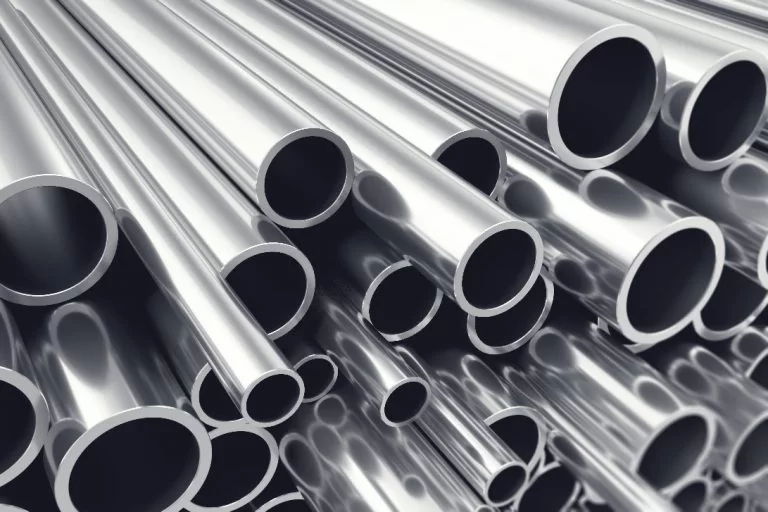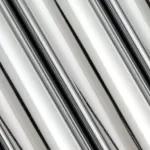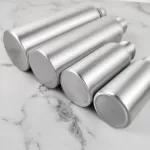Steel is a strong and versatile metal. It is an alloy consisting of iron with a small amount of carbon and occasionally other elements. The carbon directly influences the steel’s strength and durability. However, a vast array of different steels have been developed through the addition of other alloying elements such as chromium, nickel, molybdenum, and silicon. These can provide enhanced properties like abrasion resistance or corrosion resistance. There is a grade of steel for almost any application. This article will define steel, its composition, types, properties, and applications.
Learn more about this material and how it’s used in manufacturing.
Welding Town
What Is Steel?
Steel, in its simplest form, is iron metal that’s been alloyed with less than 2% carbon. However, many other elements can be added as well to create multiple grades of steel alloys with varying properties. Common alloying elements include chromium, manganese, and nickel.
What Is the History of Steel?
The history of steel begins with the history of iron. Iron’s discovery and rise to prominence in what we now call the Iron Age began in about the 12th century BCE (though it varies depending on geographical location). It is only considered to have started in Europe around the 5th century BCE. Early steels (iron with added carbon to increase strength) were made in China around that time but generally had too low an iron content to be considered true steel. It was in India around 400 BCE that true steel was created by melting iron and charcoal together in small crucibles.
Variations of steel and cast iron (which have a higher carbon content) were developed throughout the world during medieval times and into modern history. A significant step forward was discovered by Benjamin Huntsman in England in 1751 when he used geologically-sourced coal rather than charcoal from timber to heat the crucibles. An even bigger breakthrough was made by Henry Bessemer, who was awarded a British patent in 1855 for a steel-manufacturing process. His process blew air directly through the molten iron (and its additives). This became fundamental to modern commercial steel production.
It wasn’t until about 1912-1914 that stainless steel was first created with the addition of chromium and nickel. These materials were gradually developed and refined through the end of World War Two.
What Is Steel Made of?
Fundamentally, steel is made of iron and carbon, but many other alloying elements also get added to create thousands of different grades of steel. Mild steel, or carbon steel, is generally more than 99% iron, containing less than 0.25% carbon, similar amounts of manganese, and traces of phosphorus and sulfur. By contrast, a common grade of stainless steel (304) has only about 70% iron with a minimum of 18% chromium and 8% nickel. Manganese, silicon, phosphorus, and of course carbon are also present in varying amounts within this type of steel. Other alloying elements for different steels include molybdenum, vanadium, and boron. Multiple grades of each type of steel exist, with variations in their composition meant to produce different characteristics.
How Are Steels Made?
Steel is made via one of two main smelting processes — either a blast furnace or an electric arc furnace.
For a blast furnace, iron ore and coke (coal that has been treated to remove volatile components) are added to the furnace, which is fired by air. Lime is also added to reduce the iron from the ore to its metallic form. This produces so-called pig iron, which is then sent to a direct oxygen furnace for the production of molten steel.
In an electric arc furnace, the iron ore is fired first by natural gas in a direct-reduction furnace. The iron metal is then sent to the electric arc furnace for steel production. Large electrodes are submerged into the furnace where electricity is used to create high-temperature arcs between the electrodes and thus melt the metal. Alloying elements are added to the electric arc furnace section.
After either process, the molten steel is then continuously cast by a hot strip mill and then rolled into different forms such as plates, bars, pipes, and others. This can be done by hot rolling or cold rolling. Other finishing processes such as tempering or annealing can also take place depending on the steel grade being produced.
What Are the Characteristics of Steel?
The common characteristics of steel are listed below:
- Strength: Steel is a high-strength material, particularly in tension, and can be used for structural loads.
- Durability: Steel is highly durable with a potential lifespan of over 100 years. It does not swell or creep, instead remaining very rigid.
- Versatility: Steel is an incredibly versatile material. Its many grades can be applied to thousands of uses.
- Machinability: Most steel is easily machinable, depending on the grade. Some specific grades of steel (free-cutting steels) are highly machinable.
- Weldability: Most grades of steel are easily weldable, although some need specialized welding procedures.
- Corrosion Resistance: Steel can be alloyed with other elements such as chromium, nickel, and molybdenum to better resist corrosion.
- Conductivity: Steel generally has lower thermal and electrical conductivity compared to other metals. It can be employed as a strong and heat-resistant shielding material.
- Recycling: Steel can be completely recycled, and due to its value, a large portion (>60%) of steel globally is recycled.
What is the Color of Steel?
Steel is generally silver-gray, but the appearance depends on the grade of the steel and the level of oxidation. For instance, some stainless steels, when polished, are reflective silver, almost with a mirror finish. Carbon steels are generally a dull gray to start with and turn a dark brown as they oxidize.
What Does Steel Look Like?
Steel looks like a dark gray or dark brown metal, often gaining a dull or rough appearance from oxidation or rust forming on its surface. Superficial rust is often visible on the surface of steel that has been exposed to the elements for an extended period. Figure 1 contains examples of steel:
What are the Different Types of Steel?
There are several different types of steel, each defined by the type and amounts of alloying elements. These are listed below:
1. Stainless Steel
Broadly speaking, stainless steel is defined by chromium in its composition. The austenitic stainless steels (18/8 and 18/10, or 304 and 316) are the most popular and contain chromium and nickel. However, there are also martensitic and duplex stainless steels with particular engineered properties. Stainless steels are valued primarily for their excellent corrosion resistance, which also makes them easy to clean. When coupled with their temperature resistance and strength, they are central to some industries. For instance, the dairy industry and other food and beverage industries use stainless steel for nearly all their processing equipment.
2. Carbon Steel
Carbon steel generally refers to the simplest steel alloys of carbon and iron, with small amounts of manganese, phosphorus, and sulfur present. The key defining factor for each grade is the carbon content within the steel. This can range from as low as 0.05% to as high as 2%. The carbon percentage influences many properties such as the strength, brittleness (ductility), and weldability of each grade of carbon steel. Carbon steel can be used for structures, automotive components, and many other applications.
3. Alloy Steel
Alloy steel is a broad term applied to steel that contains additional alloying elements (over and above carbon) such as: chromium, nickel, molybdenum, manganese, boron, silicon, and vanadium. The alloying elements can make up 1% to 50% of the alloy. Low-alloy steel is generally considered to have below 8% alloying elements and high-alloy steel contains more than 8% alloying elements. Alloy steel is a very wide category. Its grades are used in many different applications, such as stainless steel for dairy producers, or advanced high-strength steel in the automotive industry.
4. Tool Steel
Tool steel is a range of steel grades carefully developed to function well as tools. It is extremely hard, durable, and abrasion-resistant. There are different grades of tool steel, but they generally contain between 0.7% and 1.5% carbon, are low in manganese, and are heat treated. Tool steel is used for the manufacture of jackhammer bits and forging dies, for example.
5. Weathering Steel
Weathering steel is a low-alloy steel designed to resist corrosion in outdoor applications (i.e. it is considered weather-resistant). The steel is alloyed with small amounts of chromium, nickel, and copper to improve corrosion resistance. The corrosion mechanism builds a passive oxidized layer on the surface of the steel, which inhibits further corrosion. Weathering steel is commonly employed as structural members for bridges and other structures, where it requires very little maintenance for a useful life of over 100 years.
6. Electrical Steel
Electrical steel is alloyed with silicon (generally in the range of 2-3.5%) and has uniform magnetic properties. These alloys go into electrical components such as electric motors and transformers.
7. High-Speed Steel
High-speed steel is a subcategory of tool steel specifically formulated for fast-moving tools such as rotating saw blades. The steel includes tungsten and molybdenum as alloying elements and is heat treated to create an ultra-hard surface. High-speed steel is valued for its excellent hardness and abrasion resistance.
What Are the Properties of Steel?
Steels can exhibit a range of properties depending on the grade. Table 1 below shows some steel properties:
Table 1: Steel Properties and Uses
| Property | Description | Examples of Steels | Advantages | Applications |
|---|---|---|---|---|
| Strength | Withstands high loads | High-strength low-alloy (HSLA) steel | Strength | Structural beams |
| Ductility | Flexibility | HD50 (High Ductility) | Easily shaped into various forms | Ship hulls |
| Corrosion resistance | Resistance to corrosion in various environments | Stainless steels, such as 304 and 316 | Compatible with a wide range of fluids and environments | Food and beverage processing, acidic environments |
What Are the Physical Properties of Steel?
Steel is generally known for its physical properties such as hardness and strength. Table 2 below lists some of the steel’s physical properties:
Table 2: Steel Physical Properties
| Property | Description | Examples of Steels | Typical Value Range | Units |
|---|---|---|---|---|
| Hardness | Resistance to surface deformation | Tool steel (D2) | 200 – 1180 | Brinell hardness number (kg/mm2) |
| Tensile Strength | Ability to withstand stretching loads | Chromium vanadium steel (6150) | 250 – 600 | MPa |
| Thermal Conductivity | Transmission of heat | Carbon steel (grade C1010) | 15 – 45 | W/(m•K) |
| Thermal Expansion | Change in volume with temperature | Austenitic stainless steel (304, 316) | 10 – 17 | 106m/(m•°C) |
What Are the Chemical Properties of Steel?
The chemical properties of steel vary depending on the alloy. Table 3 below lists a few chemical properties of steel:
Table 3: Chemical Properties of Steel
| Steel Type | Corrosion Resistance | Oxidation | Reactivity | Magnetic Properties | Stability |
|---|---|---|---|---|---|
| Carbon Steel | Limited | Significant, particularly in moist environments | Reactive with oxygen | Magnetic | Good |
| Tool steel | Good | Significant, particularly in moist environments | Reactive with oxygen | Magnetic | Good |
| Austenitic Stainless Steel (304, 316) | Excellent | Minimal, forms passive film | Non-reactive (inert) generally | Non-magnetic | Excellent |
| Martensitic Stainless Steel (410, 420) | Excellent | Minimal, forms passive film | Non-reactive (inert) generally | Magnetic | Excellent |
What Are the Applications of Steel?
Steel is an incredibly versatile metal and has a wide variety of types and grades. Listed below are some of its applications:
1. Transportation
Steel is used in transportation in several ways. Infrastructure such as bridges and rails are built with steel. It also forms the frames of train cars, motor vehicles, and large ships. It is the incredible strength of steel that makes it a good fit for these applications.
2. Construction
Steel is used widely in construction, primarily in the form of structural, load-bearing members. This is because of its high strength and rigidity.
3. Manufacturing
Manufacturing industries employ plenty of steel, particularly for machine components and tools. Its strength makes it a popular choice for heavy-duty applications.
4. Packaging
Steel is used in cans for food and beverages. It can be ideal because it is durable and recyclable.
5. Medical Equipment
Stainless steels are used extensively in medical equipment because they resist corrosion. They don’t naturally promote microbial growth and can easily be cleaned and even heat-sterilized. Surgical tools and medical instruments are commonly made from stainless steel.
6. Sports Equipment
Steel is used for sports equipment such as bicycles and golf clubs. It appears in items that experience heavy loads, so its strength and durability are valuable.
7. Energy Production
Steel is used in energy production and transmission for both its strength and its magnetic properties. It appears in generators, transformers, and motors. It is also used structurally in pylons and steel-reinforced electrical cables.
What Are the Benefits of Steel?
Steel has some properties that make it a very useful material:
- Strength: Steel is a strong and durable material that can withstand heavy loads and resist deformation. It is ideal for use in construction and infrastructure projects.
- Versatility: Steel can be molded, shaped, machined, and welded. It can be formed into a huge variety of components.
- Dimensional stability: Steel is very rigid, and resists deformation well.
- Recyclable: Steel is infinitely recyclable; the scrap metal may be melted down and reformed.
- Safety: Steel is a non-combustible material that does not release harmful components even when heated. This makes it a safe material to build with.
What Are the Limitations of Steel?
Steel is not a perfect material for all purposes. Its disadvantages may limit its usefulness as listed below:
- Corrosion: Steel — particularly carbon steel — corrodes in moist environments and may need protective coatings (like paint) and regular maintenance to achieve a reasonable service life.
- Weight: Steel is a relatively heavy material. That weight can limit its value in sectors such as the aerospace industry where overall mass is a major concern.
- Energy requirement: Steel smelting demands large amounts of energy. Although modern techniques have made improvements, steel’s energy footprint is still relatively high.
- Thermal conductivity: Steel conducts heat well, which can complicate the insulation, cooling, and heating of large steel buildings.
- Cost: Steel is more expensive than many other materials. That’s particularly true of specialized grades and stainless steel.
Why Use Steel?
Steel is an incredibly versatile and durable material. Because so many variations are available, there’s a grade of steel to match nearly any application. Steel’s strength makes it ideal for large structures and demanding applications. With the correct grade or coating, it can even resist corrosion. Steel also has excellent dimensional stability. It does not swell, shrink, or easily warp or creep.
Is Steel a Metal?
Yes, steel is metal. The major component of steel is iron (which itself is a metallic element), and aside from carbon, the vast majority of alloying elements in steel grades are metals. Steel is a shiny, hard, malleable metal and has good thermal and electrical conductivity.
Can Steel Rust?
Yes, steel can rust. Rust occurs when the iron in steel reacts with oxygen in the air (in the presence of water) to form iron oxide. Stainless steels, however, have alloying elements such as chromium and nickel that prevent or severely inhibit iron oxide formation.
Is Steel Stronger Than Iron?
Yes, steel is stronger than iron due to the carbon contained within its molecular structure. Generally, steel’s toughness increases with the carbon content.
Is Anything Harder Than Steel?
Yes, several materials are harder than steel. Diamond is the hardest natural material known (though it is more brittle). Silicon carbide is a manufactured material that is harder than steel. Other metals such as tungsten are also harder than steel.
What Is the Difference Between Steel and Metal?
Steel is a type of metal but not all metals are steel. Steel’s properties differ from those of other metals. Depending on the grade of steel, it can be much stronger and may corrode or resist corrosion differently.
What Is the Difference Between Steel and Aluminum?
Steel is a metal alloy of the elements iron and carbon whereas aluminum is a single metal element. This results in very different properties between the two materials: steel is strong but heavy, and aluminum has lower strength but is much lighter.










